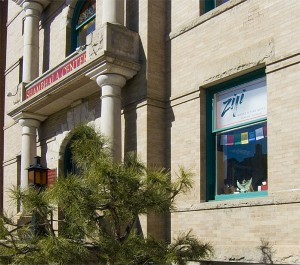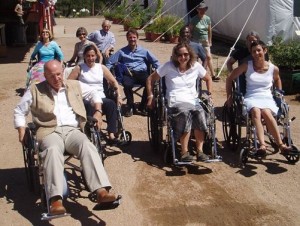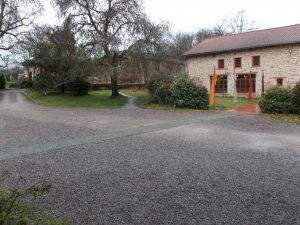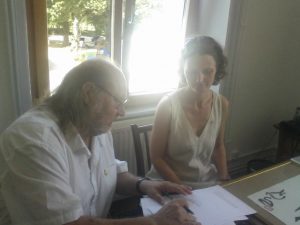Sunday
Community ArticlesChallenges and Inspiration
Expanding commitment to accessibility at Shambhala’s land centers
by Stefan Carmien
Our community has always been aware of the challenges that some of us have faced. A few of you long-time members may recall helping a fellow practitioner up the stairs of the Boulder center at 1111 Pearl in the early 1970s. There were some special one-time accommodations, like the induction loop in the 1981 seminary. However, it was not until Hamish Maclaren worked on getting a ramp for the Spruce Street building in Boulder that accessibility issues were approached in a systematic fashion. The Accessibility and Disability working group came out of the early Shambhala congresses, and the work that Hamish did on evaluating accessibility issues at Shambhala Mountain Center.
One of the inspirations for this working group was the effort to help Shambhala Mountain Center become more accessible, initially for those in wheelchairs. Starting in 2001 there have been several reports on the needed work at Shambhala Mountain Centre: a corrective actions checklist in 2001, the May 2002 Report of Shambhala Mountain Center Accessibility Survey by Josie King-Robinson and Hamish Maclaren, and a report updated in 2011 on accessible rooms.
The sense that came out of this history was that there were substantial efforts being made, at least for Shambhala Mountain Center, to document issues and produce suggestions for solving the accessibility problems. It must be stressed that this was not because of any resistance by the Shambhala Mountain Center administration to becoming accessible. More probably it was a matter of shifting priorities: as soon as the next in the ever-cascading financial emergency events happened, all the careful plans would be abandoned, as has been confirmed by interviews with several center coordinators. (It must be noted that the only substantial direct conversations with centre directors have been with Dechen Choling, and that the opinions expressed in this paragraph were formed as a result of collecting verbal histories. Our plan has been to have local members of the Working Group do the same analysis as has been done at Dechen Choling, after its successful conclusion.)
So, from this dynamic, the accessibility and disability working group came up with a plan. We provided accessibility reports that were discrete and measurable, that had explicit items to accomplish. For example, a report would not just say “make accessible to wheel chairs,” but would specify putting wheelchair friendly paving tiles in a three-foot wide path between the doors of two specific buildings. Beyond this, the list of mediations would be time phased and prioritized in harmony with realistic resource availability expectations. We see these as 6-month sets of tasks. The Working Group would offer their help with fundraising and labor. These promises would be compiled into an agreement with milestones. If any semi-annual milestone were missed, the Working Group and center administration would address the problem – either choosing a later date, or obtaining more resources. The key here is small incremental committed progress.
Land Site Example: Dechen Choling
The Working Group in spring of 2013 sent a three person evaluation team consisting of Jacqueline Schoonheim, Hjördís Seda-Carmien, Stefan Carmien to Dechen Choling, with the active support of the administration and staff. We spent a weekend evaluating each building that was used by participants. We decided to exclude facilities used only by the staff, although in the long run these should move toward being barrier-free also. The Americans with Disabilities Act Accessibility Guidelines (ADAAG) were chosen as the evaluation tool.
The ADAAG Checklist for Buildings and Facilities (2010) provides a nice 200-point checklist that has measurable items. Reviewers answer questions like this one: is the door opening width at least 32 inches clear, between the face of the door and the stop, when the door is open 90 degrees? The advantage of doing this sort of review is that the solution is explicit and the effort required is more easily calculated. At the end of the weekend we met with Simon La Haye and discussed our preliminary findings. We planned to meet again with the final report, and to work out an agreement, which was done this summer with Konstanze Brockstedt (Director of DCL) and François Grimbert (Operations manager).
The original report listed only about 40 items that needed to be done, so the situation at Dechen Choling is more tractable than we initially surmised. As a result of the initial talk, Dechen Choling immediately installed plastic paving inserts over the gravel to make the path from the Drala hall to the Chateau wheelchair accessible. This completed the initial barrier free path for small and medium sized programs, as shown in the above photo of the green pathway. Also, the entrance door of the boutique was moved to one wide enough for wheelchairs. In 2015 they remodelled the Drala shrine room with acoustic treatment materials to reduce the reverberation, after running a specific fundraising program for this part of the project.
The next steps for Dechen Choling and the accessibility and disability Working Group were to complete the final report and write up an agreement. After some negotiation about the resources available and the prioritization of tasks, the initial report was almost ready to be signed off in 2014. At the same time, the French government presented Dechen Choling with a requirement that they develop a report on the center’s accessibility and a plan to remedy the impediments. Interestingly the list was almost identical to our existing work. With a few modifications, the first rural practice center plan was accepted and signed by Dechen Choling administration, Konstanze Brockstedt, and a representative of Health and Wellbeing, Stefan Carmien. This first solid step to making the dharma truly available to all will be monitored by the working group, and modified as needed. There are plans in place for the same kind of evaluation at Karme Choling and later at both Shambhala Mountain Center and Dorje Denma Ling.
Dechen Choling’s commitment to accessibility and to obtaining the resources to do the necessary modifications promises that even when there are financial problems, the progress will continue. Following the agreement with Dechen Choling we intend to send teams to Karme Choling, Shambhala mountain and Dorje Denma Ling and repeat the process with appropriate modifications.
Congratulations to Dechen Choling for taking this first step, and also for their ongoing work to provide multi-lingual accessibility.






















Feb 6, 2017
Reply
this is great to learn! congratulations!